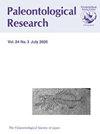俄罗斯远东萨哈林岛南部奈巴地区的晚马斯特里赫特阶(晚白垩世)菊石
IF 0.6
4区 地球科学
Q3 PALEONTOLOGY
引用次数: 0
摘要
摘要据报道,俄罗斯远东萨哈林岛南部奈巴地区Yezo群的克拉斯诺亚尔卡组有六个早-晚马斯特里赫特阶(晚白垩世)菊石类群。这些分类群分为“移民物种”,即从其他地区迁移的物种(Pachydiscus subcompressus、Anagaudryceras mikobokense、Gaudryceras seymouriense和Zelandites varuna)和北太平洋分布的“本土物种”(Anagaudyceras matsumotoi)。目前尚不清楚Tetragonites sp.属于哪个类群。Zelandites varuna和G.seymouriense既出现在库页岛南部的下-上马斯特里赫特阶,也出现在上-下马斯特里赫特纪,但从未在中马斯特里赫特期发现过。这两个物种在冷水区,即北太平洋和南极,以及中南中纬度地区的出现表明,冷却事件发生在西北太平洋地区的马斯特里赫特阶早期晚期和晚期早期。它们在马斯特里赫特阶中期的消失可能表明西北太平洋地区受到温室效应的马斯特里赫特期中期事件(MME)的影响。这一假设表明,在马斯特里赫特阶晚期,许多移民物种涌入西北太平洋地区(如P.subcompressus和A.mikobokense)和重新出现(如Z.varuna和g.seymouriense)可能与MME后的冷却有关。本文章由计算机程序翻译,如有差异,请以英文原文为准。
Late Maastrichtian (latest Cretaceous) Ammonoids from the Naiba Area, Southern Sakhalin, Russian Far East
Abstract. Six early late Maastrichtian (Late Cretaceous) ammonoid taxa are reported from the Krasnoyarka Formation of the Yezo Group in the Naiba area, southern Sakhalin, Russian Far East. These taxa are grouped into “immigrant species”, i.e., those that migrated from other regions (Pachydiscus subcompressus, Anagaudryceras mikobokense, Gaudryceras seymouriense and Zelandites varuna) and “indigenous species” with a North Pacific distribution (Anagaudryceras matsumotoi). It is unclear to which group Tetragonites sp. belongs. Zelandites varuna and G. seymouriense occur in both the lower upper Maastrichtian as well as the upper lower Maastrichtian in southern Sakhalin, but they have never been found in the middle Maastrichtian. The appearance of these two species in the cold-water regions, i.e., North Pacific and Antarctic, as well as intermediate southern mid-latitudes regions suggests that cooling events occurred during the late early and early late Maastrichtian in the Northwest Pacific region. Their disappearance during the middle Maastrichtian may indicate that the Northwest Pacific region was affected by the greenhouse Middle Maastrichtian Event (MME). This hypothesis suggests that the influx (e.g. P. subcompressus and A. mikobokense) and reappearance (e.g. Z. varuna and G. seymouriense) of many immigrant species into the Northwest Pacific region during late Maastrichtian time may have been associated with the post-MME cooling.
求助全文
通过发布文献求助,成功后即可免费获取论文全文。
去求助
来源期刊

Paleontological Research
PALEONTOLOGY-
CiteScore
1.60
自引率
0.00%
发文量
47
审稿时长
>12 weeks
期刊介绍:
Paleonotological Research (PR) is a quarterly, peer-reviewed international journal, which focuses on original contributions primarily in the area of paleontology but also covering a wide range of allied sciences. It has been published since 1997 as a successor to the former journal Transactions and Proceedings of the Palaeontological Society of Japan. The emphasis of contributions will include global and local perspectives, and contents can cover all ages (Precambrian to the Quaternary, including the present time).
 求助内容:
求助内容: 应助结果提醒方式:
应助结果提醒方式:


